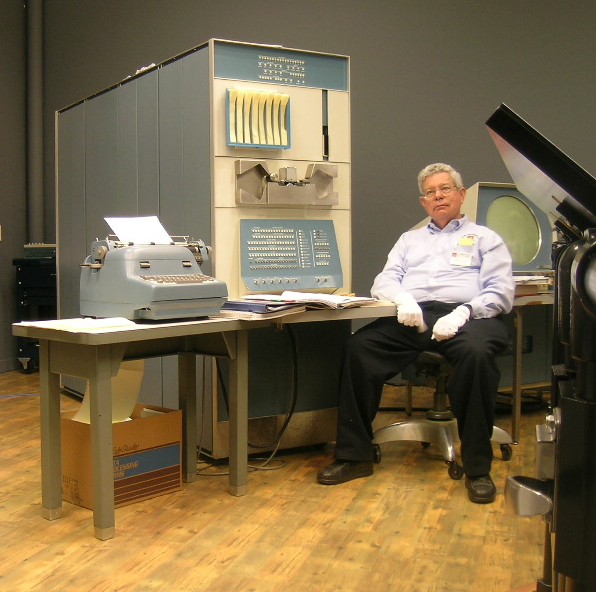Previously, we have discussed 10 of the most influential people in the development of computers. Since then, these machines which were initially seen simply as a business machine, have evolved to cater to different markets and purposes.
Computer games, in particular, have grown side-by-side with the advancement of computer technology. The two fields are intertwined, in a sense that development in one would influence the other in a positive way.
This time around, we are going to list ten of the most influential people in the field of computer games. Their contributions have paved the way for modern game titles as we know them today and provided us with a unique form of entertainment like no other. In no particular order, these are ten out of many influential people in the development of computer games of all time.
Steve Russell
One of the pioneers of computer gaming is Steve Russell, whose game Spacewar! is widely considered as one of the first video games. As an MIT student in 1961, Russell and his friends utilized the PDP-1 computer’s statistical calculations to create Spacewar! The game paved way for modern video games on computers and was widely distributed among the public domains to run on different computers.

Aside from his work on Spacewar!, Russell is responsible for the first two punch cards IBM 704 implementations of the Lisp programming language. Russell realized what John McCarthy, inventor of Lisp, thought would be impossible, that is to interpret/evaluate Lisp code instead of compiling it. In the later years, Russell proceeded to become Bill Gates’ and Paul Allen’s mentor when the two were part of the Lakeside School programming group.
Gordon Earle Moore
Known famously for his empirical approximation called Moore’s Law, Gordon Moore is one of the founders of the Intel company. As many of you might be familiar, Intel is one of the leading manufacturers and pioneers of computer microchips that essentially serve as the brain of all the technological devices, gadgets, and hence games, our world relies on.
Before producing microchips, Intel initially wanted to manufacture logic circuits based on semiconductors. However, they soon realized that their Japanese competitors were very much ahead and so they shifted to semiconductors. It was a big-brain move after all. As hinted earlier, Moore’s Law is an empirical trend which Moore posited in 1965 that projects the doubling of the number of components per integrated circuit for every two years. The trend holds true until today.
William Crowther
Before the dawn of computer graphics-based video games, most computer games were based on text-based commands. As a player, you interact with the system through different commands to which the system would respond, and thus the game would then continue to build on. One of the first text-based games was William Crowther’s Adventure.
The game Adventure was first built for the PDP-11 minicomputer and requires its players to enter two-word commands in order to navigate around. Soon after, computers became powerful enough to render prettier graphics, but Adventure served as the precursor for the adventure game genre and other role-playing computer games.
Tim Sweeney
Tim Sweeney is perhaps best known for founding one of the leading game developers and publishers of today, Epic Games. But before the company bloomed to its glorious era, Sweeney began by developing a game known as ZZT, which later became the basis of Potomac Computer Systems’ initial success in game development. Soon after that, he decided to rename his company to Epic MegaGames.

Epic MegaGames’ next successful title was the first-person shooting game Unreal. In the process, however, Sweeney developed a game engine, called Unreal Engine, that would eventually shape the foundation of today’s video games like Fortnite, PlayerUnknown’s Battleground, VALORANT, and many others. With it, developers are able to create 3D games that run on versatile platforms and even made influences on the film and television industry.
John Carmack
If some of you grew up in the early 90s, you’re probably familiar with video game titles like Wolfenstein, Doom, Quake, and their various renditions afterward. These titles are all products of id Software, a video game developer founded by four individuals, including John Carmack. Aside from these nostalgic titles, Carmack has made long-lasting impacts in the technical side of game development that allowed for modern titles like Half-Life and Call of Duty.

Particularly, Carmack popularized the usage of techniques known as adaptive tile refresh, ray casting, binary space partitioning, surface caching, z-fail stencil shadows, and various other very technical computer graphics methods. Also, Carmack is a huge advocate for open-source software over software patents, allowing others to build and work on top of the code Carmack and his team have written.
Gabe Newell
If you’re like me and grew up playing games in the early 2000s, the game distributor Steam shouldn’t be fairly new to you. And the name Gabe Newell, nicknamed Gaben, is all too coupled with the platform that he and his company Valve created. With Valve, Gabe funded the development of older game titles like Half-Life, as well as the GoldSrc game engine. The GoldSrc engine evolved into the more modern game engine known as the Source Engine.
Speaking about Source Engine, it is the very engine that the games Counter-Strike and Half-Life: 2 run on. Later down the line, it too became the engine on which esports titles like Dota 2 and Counter-Strike: Global Offensive live on. Steam became the home and distributor of these two beloved games alongside countless others.
David Brevik
Dubbed one of the most influential people in computer gaming of 1996, David Brevik is a video game creator of Diablo. Although, of course, the game itself was a joint effort of a group of developers, Brevik spearheaded much of the game’s early development and made much of the internal decisions within the development of Diablo.

More importantly, Diablo paved way for action and RPG games to enter the realm of computer gaming. Later on, Brevik’s company Condor Games was acquired by the company Blizzard Entertainment. With the immense popularity of Diablo as an RPG game, titles like World of Warcraft would soon follow the same path lit by Diablo.
Shigeru Miyamoto
Although the Japanese video game company Nintendo rarely dabbles with the field of computer gaming, their all-time popular video game titles like Mario Bros. and The Legend of Zelda surely have influenced young children of their time to play games in the comfort of their homes. Not to mention, a lot of arcade and PC game developers have also probably found inspiration by playing Nintendo’s games.
Shigeru Miyamoto is the man behind the design of both Super Mario Bros. and The Legend of Zelda. They are two out of countless famous arcade games played on the Nintendo Entertainment System and reached quite a significant percentage of the console game market.
Hideo Kojima
Like Miyamoto, Hideo Kojima is a Japanese video game designer that had a massive influence in the realm of gaming. Kojima specifically impacted the genre of stealth games with the creation of one of his most popular titles of all time, Metal Gear. Metal Gear ran on a home computer known as MSX2, with its future renditions running on both PC and various console platforms.
Kojima’s achievements would continue to rack up until today, including one of his independent studio’s first video game titles called Death Stranding. Though his primary field is video games, Kojima found multiple inspirations from movies and films. Returning his favor back to the movie industry, Kojima has spoken about producing his own films, thus completing his circle of inspiration.
Ivan Edward Sutherland
We shall end the list with the person dubbed as the father of computer graphics, Ivan Edward Sutherland. During his time as a professor in the Computer Science Department at the University of Utah, Sutherland and his colleague David Cannon Evans founded the company, Evans & Sutherland. The company pioneered the earliest works involving 3D computer graphics which would not only bleed to video games, but also movies.
In fact, some of the company’s former employees included other legendary figures like Adobe founder John Warnock, Pixar co-founder Ed Catmull, Oracle’s Scott P. Hunter, and many more. Sutherland would also continue to win a Turing Award, oftentimes considered the Nobel Prize of Computer Science, for his program known as Sketchpad. Sketchpad formed the foundations of graphical user interfaces, which are pretty much found in almost every software we use today.
Featured Image via Wikimedia Commons.













